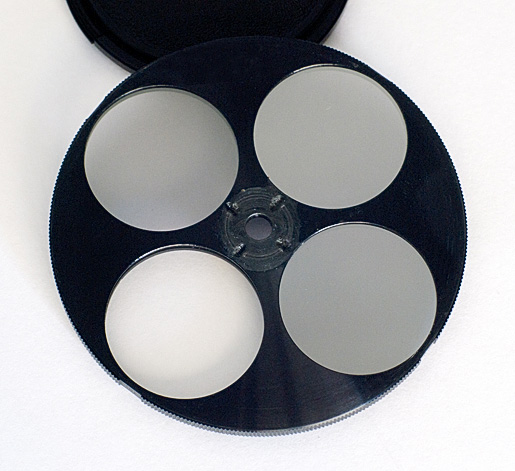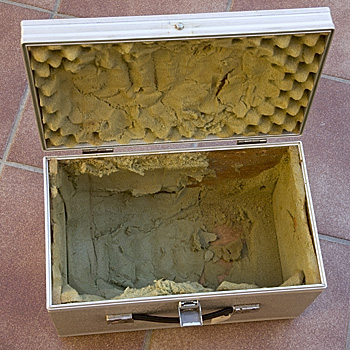by TRA
The Kilfitt
Zoomar Sport-Reflectar 500mm f/5.6
mirror lens for
the Pentacon Six

[zm500_04.jpg]
This lens was apparently designed by the American Zoomar company but manufactured in the Kilfitt factory in Munich in what was then West Germany. The lens name ring bears the words “ZOOMAR MUENCHEN SPORT-REFLECTAR 1:5.6 500mm Nr. [and the serial number]”. “MUENCHEN” is a way of transcribing the German name for Munich, München, when the u-umlaut (“ü”) is not available on the keyboard (or in former times, with telegrams, for instance).
1:5.6 is a popular German way of specifying a maximum aperture of f/5.6. The disk in front of the centrally-placed rear-facing mirror has the Zoomar logo, which contains the words “Kilfitt” and “ZOOMAR”. The lens is also engraved “Lens made in West Germany” on the back surface.
The lens cap says “Zoomar West Germany”.
Versions of the
Kilfitt/Zoomar 500mm Sport Reflectar
Patrice-Hervé Pont’s book “Kilfitt
Zoomar” (see here)
reports two versions of this lens. However, a
Pentacon and Kilfitt expert from Germany tells me that
there were in fact three versions:
- a first version with a filter-revolver, designed to cover 24 × 36mm (35mm “full frame”)
- a second version (Pont’s “Première version”) for 6 × 6 medium format, with the code prefix 278
- a third version (Pont’s “Seconde version”) for 6 × 6 medium format, with the code prefix 292 (indicated in Pont as also having code prefix 278).
(On prefix codes, see here.)
I have no desire to criticise Pont, who
has done a remarkable job uncovering and assembling
information on Kilfitt and Zoomar and making it
available to anyone interested. However, he
himself recognises that the information provided in his
book is unlikely to be complete.
I have two versions of this lens:
| Serial number prefix code |
Characteristics |
| 278 |
|
| 292 |
|
Both of these lenses have the WE camera adapter base, which was the newest of the three camera adapter systems used by Kilfitt (see here). With the standard Pentacon Six WESI camera mount, they fit the Pentacon Six and provide infinity focus.
The photographs in Pont’s book show a version that has a lens shade, but no filter revolver (although he mentions the revolver in his description), as well as one that matches my lens that has a 292 prefix. I don’t know if this is a further, undocumented version or a first or second version from which the filter revolver has been removed (which seems unlikely, as that would leave a gap through which light would enter).
Here I describe the two versions that I have, and in my lens tests section I show pictures taken on the Pentacon Six with these two lenses (links below).
Version 278
The image at the top of this page is of this version.
| Focussing
There is no other lettering on the lens: no indication of focussing distance and no focussing index mark. In consequence of this, there is of course also no depth-of-field scale. There are two focussing knobs on this lens, both slightly under the lens and near the back, for easy operation with the left or the right hand. An unusual feature with this lens is that the focussing is internal. Rotate one of the focussing knobs while looking through the viewfinder and the image will come into sharp focus, but the external body of the lens does not increase or decrease in length. (The rear mirror is moved within the lens housing.) With this particular example of this lens, there is no option to fit a focussing lever. However, some later versions of the lens were produced with such a lever, which is in any case removable and often appears to have been lost by a previous user. Tripod sockets The underside of this lens has two tripod sockets, for ¼ “ and for 3/8”. It may be possible to use this lens on a bean bag or other suitable support (for instance, a cushion on open a car window). However, for most use it is best placed on a tripod – as indeed would be the case with any lens of this focal length. The tripod sockets are mounted directly onto the lens, not onto a tripod collar, so it is not possible to rotate the mount round the lens. On uneven ground, a level setting must be obtained by adjusting the length of one or more of the tripod legs. |
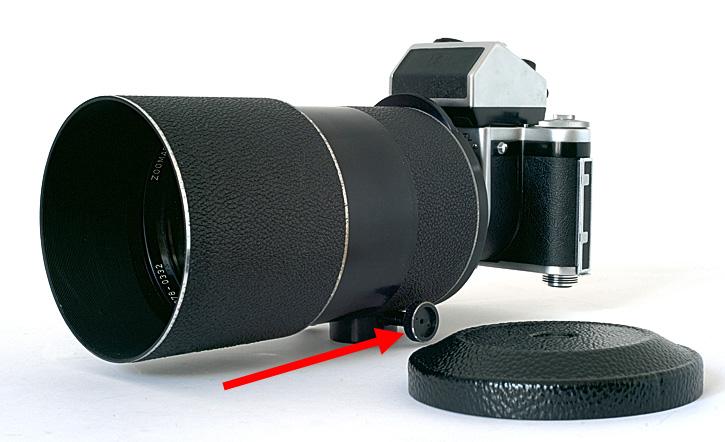 [zm500_02.jpg] The left-hand focussing knob can be seen in this image (arrowed) |
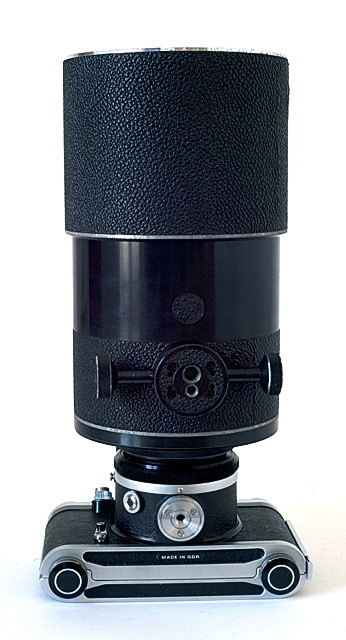 [zm500_06.jpg] The two tripod sockets (and the other focussing wheel) can be seen in this image. |
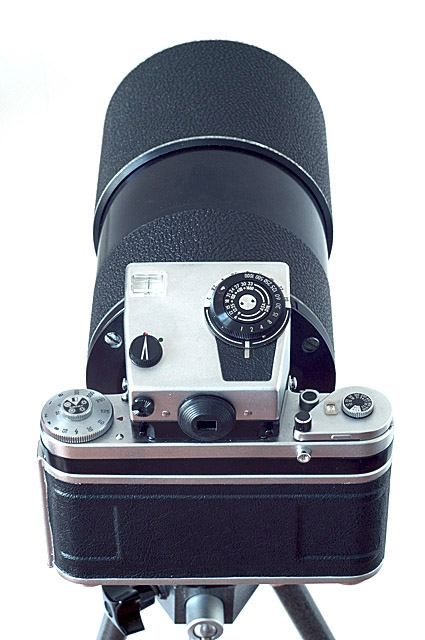 [zm500_05.jpg] A user’s-eye view of the lens mounted onto the Pentacon Six |
This lens has a deep integrated lens shade that is simply pushed forward to shield the lens from unwanted stray light from outside of the image area. This will in most cases improve contrast and reduce flare considerably, so it should be used. Because of the integrated design, there is no chance of leaving it at home or losing it, two fates that often befall lens shades. There is some question as to whether or not the lens shade will introduce vignetting (darkening of the corners). If it has been correctly designed, and if the lens is used on a camera of the appropriate format, no vignetting should occur. The results of our lens tests will resolve this issue.
This lens hood can be seen in the fully
forward position in all the above pictures.
| Aperture
values
As is well-known, it is not normally possible for mirror lenses to have a variable aperture. In practice, this means that the only way of controlling the exposure (apart from by selecting film of a suitable speed or sensitivity) is to change the shutter speed. However, this Zoomar lens has perfected a concept that was not new, the use of filters at the back of the lens. But whereas the Carl Zeiss Jena Spiegelobjektiv has one neutral density filter and then a range of different coloured filters, the designers of this lens realised that most people preferred to shoot in colour, so there are no coloured filters (which would of course normally only be used with black and white film). Instead, this lens has three neutral density filters of different densities and one plain glass filter. These four filters are mounted on a large wheel or disk, the edge of which protrudes above the top of the lens. Corresponding to each filter there is a marking on the edge of the disk. However, instead of reading
“ND×2”, “ND×4”, etc, f/stop values are
marked. This is not strictly-speaking
technically accurate, as the aperture is not
changed. Therefore rotating this wheel
cannot increase (or decrease) the depth of
field in the resultant image. However,
using these numbers may be easier for some
users to understand, taking away the need to
make exposure calculations.
For the picture on the right, I removed the filter wheel from the lens. (This is not something that I recommend that you do, as it involves partially dis-assembling the lens!) Here you can see the four filters. Because of the shadows cast by the ND filters onto the background paper in this picture, it is not possible to appreciate exactly the different densities, but I can assure you that each of the filters is different and results in exposure equivalent to the f/-stop values given on the edge of the wheel. |
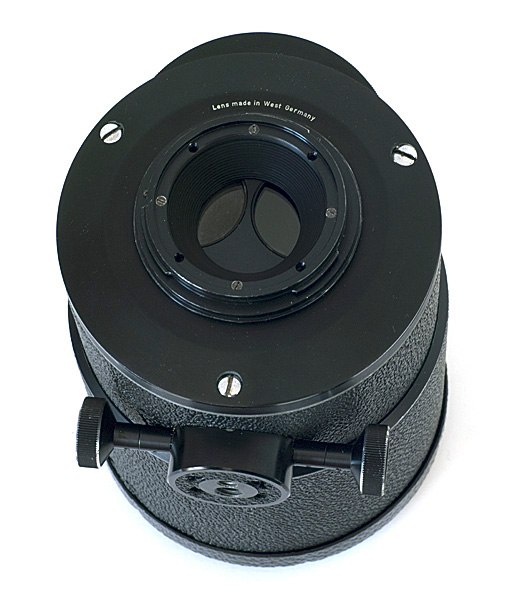
The filter wheel clicks into position for each of the filters. However, here I have deliberately partly rotated the wheel, to leave the filters in an intermediate position, so that it is possible to see how they are mounted.
|
Because of the use of f/ numbers to
indicate the effect of each filter, the user reading off
combinations of shutter speeds and apertures from a
hand-held meter will easily know which shutter speed to
set, depending on the “aperture” (i.e. the filter)
selected. Naturally, those using a metering prism,
as here, merely need to centre the needle in the
viewfinder as normal, in this case by doing the
following:
1) choose a filter
2) rotate the meter dial (in stop-down
mode) until the needle is at the meter index mark
3) check the shutter speed that is nearest
to the index mark on the metering prism and set that
speed on the camera.
If a suitable speed is not offered, change
the filter (or select “f/5.6”, which puts the clear
glass filter in the light path) and repeat steps 2) and
3).
| Case
The lens is supplied in a smart aluminium case. However, some 40-50+ years after manufacture, the foam lining of the case has disintegrated, as can be seen from this photograph.
Nevertheless, it is possible to obtain suitable foam, which these days is usually supplied in a light grey colour. |
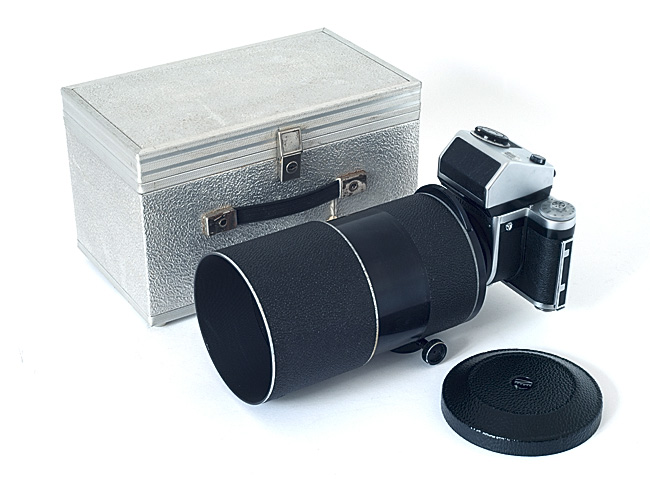 [zm500_03.jpg] |
 [zm500newfoam.jpg] |
The foam in the lid, which has an undulating surface, is called “convoluted foam” and it can be found on the web both in the UK and in the USA (and no doubt in other countries, too). Suppliers will cut the foam to size, which is what I had done here. However, note that with convoluted foam the minimum thickness from the supplier that I found is 40mm, which is a little more than I would have preferred for the lid. |
Size and Weight
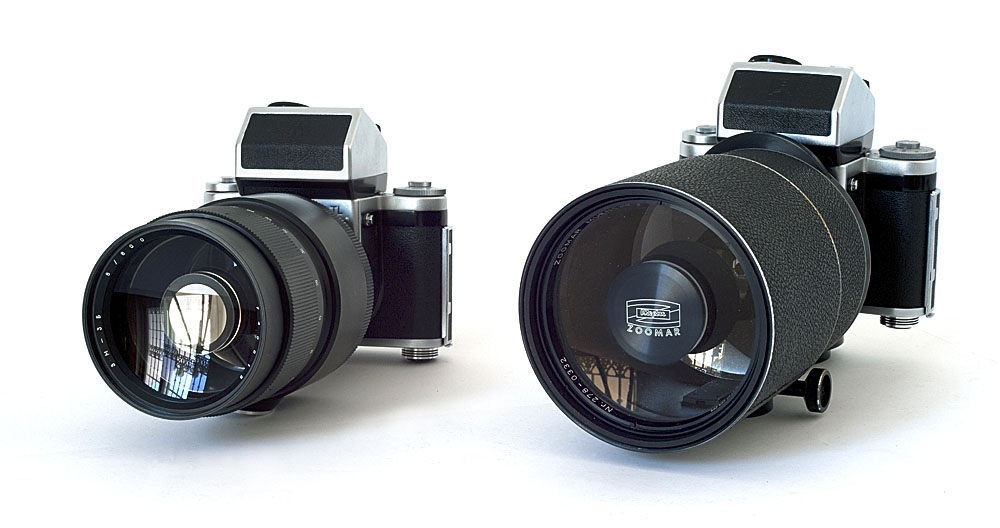
[zm500_07]
To give a better idea of the size of
this Zoomar lens, it is here pictured alongside the
Arsenal 3M-3B 600mm f/8 mirror lens.
Inevitably, the f/5.6 Zoomar lens is of
necessity larger than the f/8 Arsenal lens.
Here it is shown with its lens hood
retracted.
Key data
| Lens | 500mm Sport-Reflectar 278 |
600mm Arsenal 3M-3B | 500mm Pentacon | 500mm Arsat APO |
| Maximum aperture | f/5.6 | f/8 | f/5.6 | f/5.6 |
| Minimum aperture | – | – | f/22 | f/45 |
| Filter size | 118.5 mm 1 | Front: M 98 × 1 Rear: M 52 × 0.75 |
118 × 1 | 95 × 1 |
| Weight with front cap | 2655g | 2200g | 3500g | 1650g |
| Rotatable tripod plate collar | No | Yes | Yes | Yes |
| Tripod socket size | ¼" and 3/8" | ¼" and 3/8" | 3/8" | 3/8" (to be checked) |
Note
1 There is,
however, no thread for mounting filters to the front of
the lens. The rear filters are approximately
35.8mm in diameter. However, they are not designed
to be replaced and anyone seeking to do so would need to
disassemble the lens.
_____
The weight of this lens compares extremely favourably with other 500mm lenses. The larger maximum aperture of the Zoomar lens results in a lens that is heavier than the Arsenal mirror lens. Both of these mirror lenses are approximately 1 kg heavier than the 500mm Arsat, but 1 kg lighter than the 500mm Pentacon lens.
Its minimum length when mounted on the
Pentacon Six is approx 180mm, which is extremely short
for a 500mm lens.
Its maximum length (with the lens shade
fully extended but no lens cap in place) is approx
238mm.
Largest diameter: approx 136.3 mm
To this must be added the size of the
tripod-mounting plate or platform.
Date of manufacture & current condition
I would suspect that the Zoomar was last produced at the end of the 1970s. The Pentacon 500mm lens was produced from the late 1950s until about 1990, and the Arsat was produced in the mid 1990s. Several small batches of the 3M-3B were produced between the mid 1970s and probably about 1990.

[zm500_01.jpg]
Many decades after manufacture, and
having been stored by a previous owner in an unknown
environment, the surface finish of this Zoomar lens is
now slightly mottled. However, this is not
particularly obvious even when the front surface of the
lens is carefully studied, and it appears to have no
effect on the quality of images produced by the lens.
Lens mount
Like other Kilfitt and Zoomar lenses, this lens was available for a range of Medium Format cameras with focal plane shutters. For use on the Praktisix/Pentacon Six it requires the “WESI” mount on the WE base. The WE base is held in place with four screws, and both the base and the mount can be changed if required, in order to mount the lens on other cameras – always assuming that you can find the appropriate mount or can get one made.
Results of tests with this lens can be
seen here.
Version
292
As indicated above, this version has
no filter revolver and no lens shade. The best
way to see the other differences between the two
versions is with side-by-side photographs of the two
lenses.
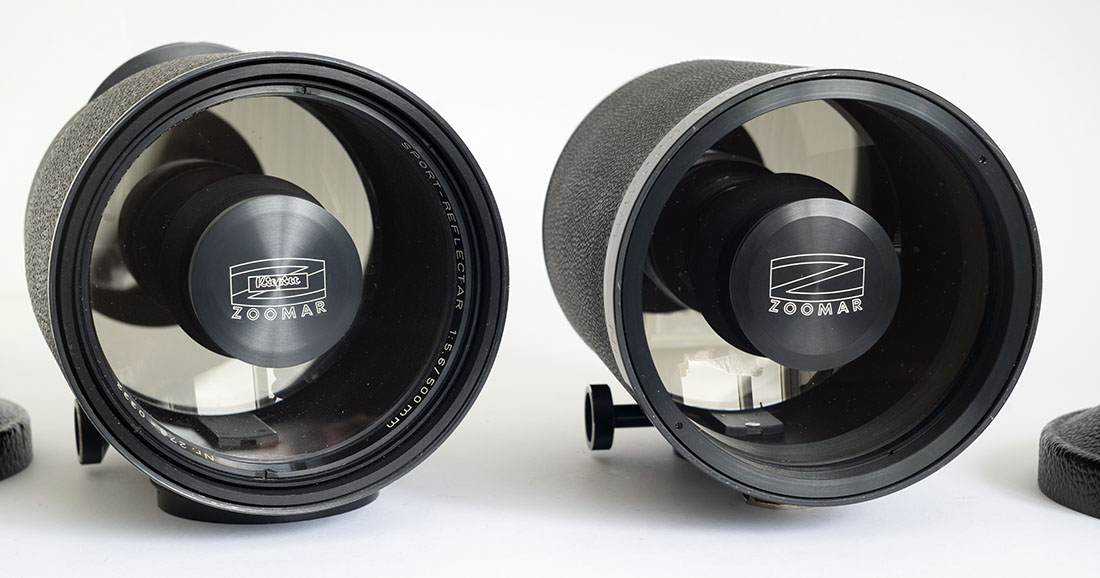
Here on the left, a lens with code prefix 278, on the right, a lens with code prefix 292.
The absence on the 292 lens of the name “Kifitt” within the Zoomar logo is another indication that it is newer.
[2SR_01.jpg]
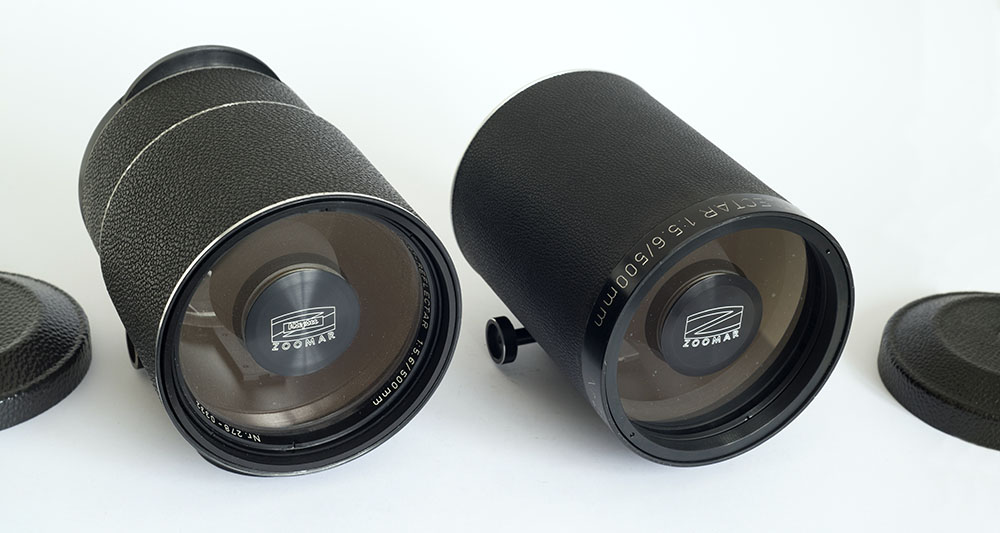 This higher angle makes it easier to see the filter revolver protruding out of the top of the 278 lens on the left. In this picture, the lens hood on lens 278 is fully retracted. Lens 292 does not have a lens hood. We also note the different location of the engravings on each lens. [2SR_03.jpg] |
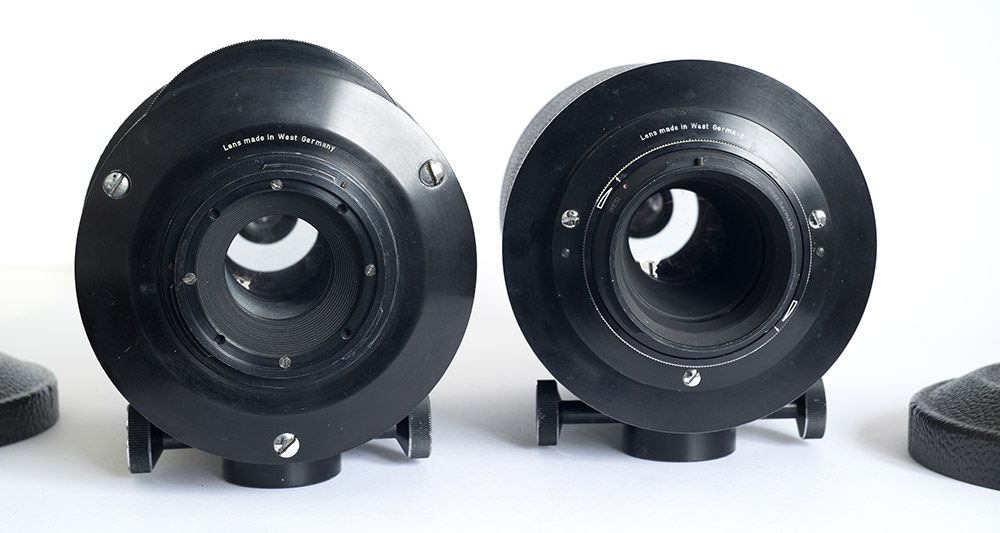 In this rear view, lens 278 is still on the left. It has an unknown camera mount on its WE base. The 292 lens on the right has a WESI Praktisix/Pentacon Six mount on its WE base. Other design differences are visible (note position of three large chrome bolts) [2SR_06.jpg] |
 This view of the underside of the two versions of the lens shows the two tripod mounts and the focussing wheels. [2SR_02.jpg] |
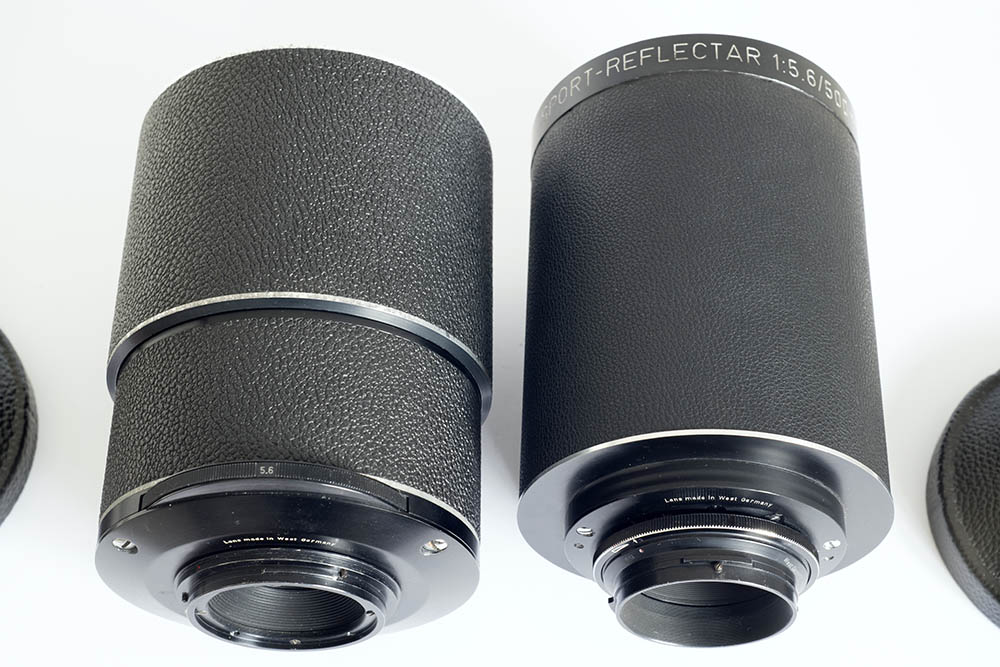 On the 278 lens we see the top of the filter wheel. On the 292 lens the filter drawer was missing, and I have covered the slot with masking tape. A slight indentation can be seen over most of the width of the top of the filter drawer holder. [2SR_07.jpg] |
 The newer 500mm Sport Reflectar on a late-production Pentacon Six. The focussing handle has here been inserted on the right-hand side. [2SR_10.jpg] |
| Mounted
on a tripod, ready to use! |
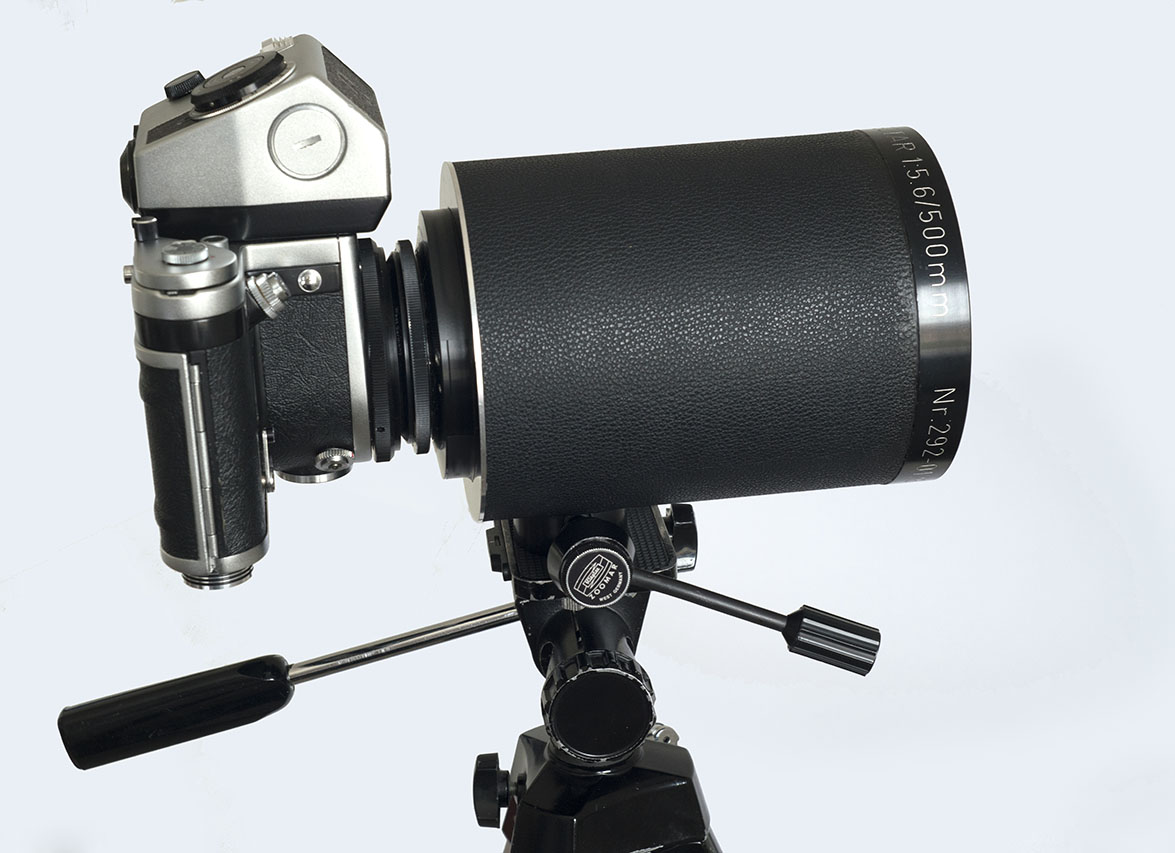 |
Results of a test with this lens can be seen immediately below the results with the older, 278, lens, here.
To go on to the next Kilfitt lens, click
below.
Zoomar Kilfitt 1000mm
Sport Reflectar lens
To go to the lens test section, click here.
To go to the introduction to Kilfitt data, click here.
To go back to the beginning of the Lens Data section,
click below and then choose the range of lenses that you
want to read about.
Back to beginning of the Lens Data
section
To choose other options, click below.
Home
© TRA First published: May 2012
Latest revision: November 2020

